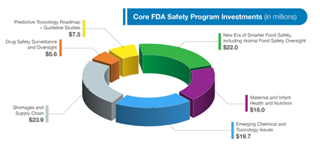TAG’s Take on the FDA and USDA FY2022 Budget Requests
Over the last month or so, both FDA and USDA announced their FY2022 budget requests. It comes as no surprise that a key element of FDA’s food safety budget would be dedicated to the activities associated with the New Era of Smarter Food Safety blueprint, which FDA released in 2020. The specifics of the initiatives are also to be expected, but there is at least one area we see as significant – though FDA gave it no more billing than any other initiative. That is its preparation for the late 2022 publication of the Food Traceability Rule.
While this is not news, as the proposed rule was published in September 2020, and FDA is required by consent decree to publish the rule by November 2022, it is an area for which TAG has been advising the industry to prepare. However with the challenges of COVID occurring so soon after the publication of the proposal, it is likely that industry preparatory focus on the rule shifted significantly. Now that FDA has specifically noted its preparation for implementation of the rule, it is important that the industry take a renewed look at the proposed rule and be at least thinking about its implementation in your facilities.
For USDA-regulated facilities, the budgetary focus appears to be more on equity building and improving capacity and efficiency for farms and facilities, both in its FY 2022 budget request and through a recent investment in grant funding.
Following are key points of the proposed budgets for FDA and USDA:
FDA. In her Congressional Testimony on FDA’s FY2022 budget request, FDA Acting Commissioner Janet Woodcock explained the program level request as totaling $6.5 billion, with $3.6 billion in discretionary budget authority and $2.9 billion in user fees. She further detailed that $97 million was to be invested in core food and medical product safety programs to reduce the number of foodborne illnesses through implementation of the New Era of Smarter Food Safety Blueprint; improve maternal and infant nutrition and health; address emerging food-related chemical and toxicological issues; and strengthen oversight of animal foods.
Related directly to food safety, the plan includes +$44.8 million/46 full-time equivalents in staffing for New Era initiatives and domestic mutual reliance/animal food safety oversight to include:
- Prepare for implementation of the Food Traceability Rule to be published in late 2022.
- Formalize root cause analysis procedures to broaden the use of rapid deployment tools; further develop new predictive analytical capabilities.
- Conduct outreach and complete an evaluation of the regulatory landscape to assess needs for future guidance, education, outreach, and compliance activities.
- Develop food safety culture goals, including tools for assessing and measuring progress and internal training for FDA inspectional staff.
- Strengthen project management capabilities, IT development support for critical analytics tools, and stakeholder engagement.
- Fund FDA’s National Center for Toxicological Research for development of data-driven tools to better understand foodborne pathogens.
- Provide funding to states to expand efforts to modernize, harmonize, and transform the U.S. animal food inspection system into one that is comprehensive and preventive.
- Update inspection and enforcement programs, develop outreach and training initiatives, and devote resources to the analysis of controls for expected, and understanding of unknown, animal food hazards.
The budget request also includes a key focus on infant formula, providing $18 million to enhance premarket review; address toxic elements in foods commonly consumed by babies and young children; and promote dietary patterns recommended by the dietary guidelines while mitigating risk of exposure to dietary toxicants. The funding is intended to expand the agency’s capacity to review the increasing number, size, and complexity of infant formula submissions and reduce exposure to toxic elements from foods eaten by babies and young children to as low as possible. (The full budget proposal is available here.)
USDA. In late May, Agriculture Secretary Tom Vilsack released a statement on the proposed FY2022 budget for the USDA. Key components would include:
- $700 million to provide access to quality broadband to rural residents and address tribal community challenges to help serve as an economic equalizer and create high-paying union jobs in rural America.
- $6.7 billion for the Special Supplemental Nutrition Program for Women, Infants, and Children (WIC) to help vulnerable families, address racial disparities, and combat rising food insecurity.
- An increase of nearly $1.5 billion for climate smart agriculture, climate resilience and clean energy to support effective land management decisions, partnerships with local communities and Tribal Nations, and ecological resilience and the underlying conditions of drought that are worsening fire seasons.
- $4 billion for USDA research, education, and outreach programs focused on making investments in agricultural research to put science and data-driven tools and American technologies in the hands of American farmers – and equip them to out-compete the world.
In addition to the proposed FY2022 budget, USDA recently invested $55.2 million in competitive grant funding available through the new Meat and Poultry Inspection Readiness Grant (MPIRG) program funded by the Consolidated Appropriations Act of 2021. Through MPIRG, meat and poultry slaughter and processing facilities can apply for grants to cover improvements to achieve a Federal Grant of Inspection or to operate under a state’s Cooperative Interstate Shipment program. USDA encourages applications that focus on improving capacity and efficiency; developing new and expanding existing markets; increasing capacity to better meet demand; maintaining strong inspection and food safety standards; obtaining a larger commercial presence; and increasing access to slaughter or processing facilities for smaller farms and ranches, new and beginning farmers and ranchers, socially disadvantaged producers, and veteran producers.
It is, of course, to be noted that the FY2022 budgets are still in proposal stages. However, we can expect that the areas of focus noted by FDA and USDA will stay the same – with priority given to those for which the agencies are proposing the highest dollars. The initiatives just may not be able to have as much projected focus if the proposed budgets are reduced by much.
Overall our take on these budget requests is that there are not huge surprises and there is the expected focus on technology solutions for some of FDA’s initiatives. There does not really seem to be a food sector that is going to get a lot more attention than in the past. But some of these requests are significant, and it is always interesting to see what FDA and USDA actually will do with the new money they receive.





